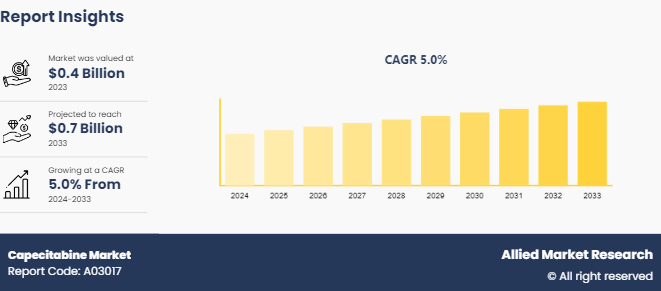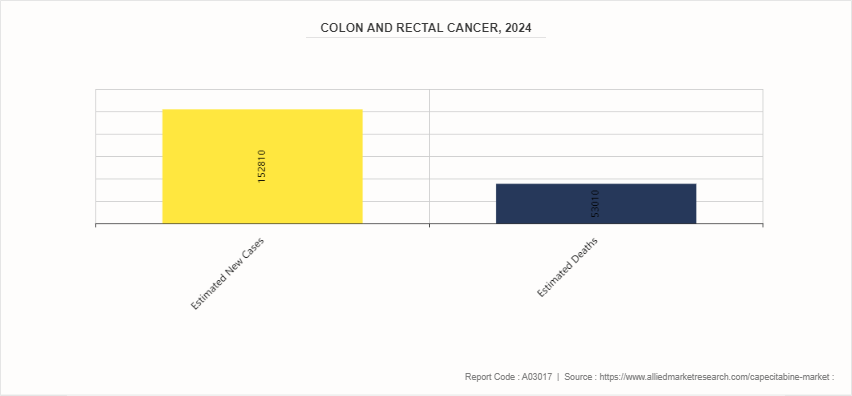Capecitabine Market Research, 2033
The global capecitabine market size was valued at $0.4 billion in 2023, and is projected to reach $0.7 billion by 2033, growing at a CAGR of 5% from 2024 to 2033. The major factors driving the growth of the capecitabine market are surge in prevalence of cancer, improved healthcare access, rise in research and development to enhancing the efficacy and safety profiles of capecitabine.

Market Introduction and Definition
Capecitabine is an oral chemotherapy medication used in the treatment of various cancers, including breast, colon, and rectal cancers. It belongs to a class of drugs known as antimetabolites, which work by interfering with the growth and spread of cancer cells. Capecitabine is a prodrug, meaning it is converted into its active form, 5-fluorouracil (5-FU) , in the body. Once converted, 5-FU inhibits the synthesis of DNA and RNA in cancer cells, ultimately leading to their death. Unlike traditional chemotherapy drugs administered intravenously, capecitabine is taken orally, usually in the form of tablets. This offers convenience to patients and allows for outpatient treatment in many cases. Furthermore, capecitabine has shown promise in combination therapies, enhancing its effectiveness in targeting cancer cells while minimizing adverse effects. Its versatility in combination with other drugs or therapies allows for tailored treatment approaches based on individual patient needs and cancer characteristics. For instance, oxaliplatin and capecitabine is a chemotherapy combination known as Xelox, which is used for the treatment of bowel cancer (colorectal cancer) , cancer of the food pipe (oesophagus) , and stomach cancer.
Key Takeaways
The capecitabine market study covers 20 countries. The research includes a segment analysis of each country in terms of value ($million) for the projected period 2023-2032.
More than 1, 500 product literatures, industry releases, annual reports, and other such documents of major energy storage system industry participants along with authentic industry journals, trade associations' releases, and government websites have been reviewed for generating high-value industry insights.
The study integrates high-quality data, professional opinions and analysis, and critical independent perspectives. The research approach is intended to provide a balanced view of global markets and to assist stakeholders in making educated decisions to achieve their most ambitious growth objectives.
Key Market Dynamics
Key factors driving the capecitabine market growth are rise in prevalence of cancer, surge in geriatric population, and high research and development activities to evaluate new pharmacological application of capecitabine. With growing number of cancer patients globally, there is surge in demand for the effective treatment option. For instance, according to the National Cancer Institute, it was estimated that in 2024, 2, 001, 140 new cases of cancer will be diagnosed in the U.S. Capecitabine, being an oral chemotherapy medication with demonstrated efficacy against various types of cancers, including breast, colon, and rectal cancers, has become a key player in the oncology landscape. Its convenience of oral administration provides a significant advantage, particularly in settings where intravenous chemotherapy may be less feasible or accessible. Thus, the high research and development activities on capecitabine and growing prevalence of cancer is expected to driver capecitabine market size.
Furthermore, according to capecitabine market forecast analysis, rise in geriatric population has emerged as a significant driver of the capecitabine market. As individuals age, they become more susceptible to developing cancer due to factors such as accumulated genetic mutations, weakened immune systems, and prolonged exposure to carcinogens over their lifetime. This demographic shift toward an aging population has led to a higher prevalence of cancer diagnoses among older adults, creating a greater demand for effective cancer treatments like capecitabine.
Patient Population
Colorectal cancer has seen an increase in incidence rates in recent years. One significant factor contributing to this growth is the aging population, as older individuals are more susceptible to developing cancer due to factors such as accumulated genetic mutations and prolonged exposure to environmental carcinogens. In addition, lifestyle factors such as diets high in red and processed meats, low fiber intake, sedentary lifestyles, obesity, and smoking have been linked to an increased risk of colorectal cancer. As these unhealthy lifestyle choices become more prevalent globally, particularly in urbanized and industrialized regions, the incidence of colorectal cancer continues to rise. Moreover, improvements in screening and diagnostic technologies have led to earlier detection of colorectal cancer cases, which, while beneficial for patients, also contribute to the growing patient population as more cases are identified.

Market Segmentation
The global capecitabine market is segmented into indication, drug type, end user, and region. By indication, the market is divided into colorectal cancer, breast cancer, and others. By drug type, market is divided into branded and generic. By end user, the market is divided into hospitals, homecare, specialty centers, and others. Region wise, the market is analyzed across North America, Europe, Asia-Pacific, and LAMEA.
Regional/Country Market Outlook
In developed regions such as North America dominated capecitabine market share owing to robust healthcare systems, well-established pharmaceutical industries, and high levels of cancer awareness and screening. These regions typically account for a significant share of global capecitabine market, driven by the widespread adoption of the drug in cancer treatment protocols and the presence of favorable reimbursement policies that facilitate patient access to the medication. According to capecitabine market opportunity analysis emerging markets, particularly in Asia-Pacific and Latin America, the capecitabine market is experiencing rapid growth due to increasing cancer incidence rates, expanding access to healthcare services, and rising healthcare expenditure. Governments and healthcare providers in these regions are increasingly recognizing the importance of oral chemotherapy drugs such as capecitabine in improving treatment outcomes and patient convenience, leading to greater adoption of the medication in clinical practice.
According to the American Cancer Society estimates that 152, 810 people in the U.S. will be diagnosed with colorectal cancer in 2024.
According to 2024 article by the National Library of Medicine, it was reported that in 2020 breast cancer accounted for 13.5% of all new cancer cases in India.
As per 2024 article by World Health Organization, it was reported that breast cancer is the most common cancer prevalent women with an estimated incidence of 604, 900 in 2022.
The Government of India stated that constant increase in public health expenditure year-on-year. In 2022, expenditure was $63 billion, or 2.1% of GDP, putting the government on track to reach its target of 2.5% by 2025.
Industry Trends
According to the Center of Disease Control and Prevention, it was estimated that 152, 810 new cases of colon and rectal cancer are expected to be diagnosed in 2024.
According to 2024 report by the National Cancer Institute, it was reported that the combination of capecitabine and oxaliplatin (CAPOX) is an accepted standard therapy in patients with metastatic colorectal cancer.
According to 2023 article by the National Library of Medicine, a randomized phase III study was conducted to evaluate capecitabine in combination with either lapatinib or pyrotinib in patients with HER2-positive breast cancer or metastatic breast cancer who previously received trastuzumab, taxanes, and/or anthracyclines. The study concluded that the combination therapy of capecitabine with pyrotinib resulted in the higher survival rate as compared to combination of capecitabine with lapatinib.
According to 2021 article by the National Library of Medicine, it was reported that capecitabine is widely used in either monotherapy or in combination therapy for treating colorectal cancer.
Competitive Landscape
The major players operating in the capecitabine market include F. Hoffmann-La Roche Ltd., Mylan N.V, Teva Pharmaceutical Industries Ltd., Sanofi, Pfizer Inc., Dr. Reddy’s Laboratories Ltd., Novartis AG, Bayer AG, Eli Lilly and Company, and Merck & Co., Inc. Other players in capecitabine market include GlaxoSmithKline Pharmaceuticals, Sun Pharmaceutical Industries Ltd, Aurobindo Pharma, Lupin, and Alkem Labs Ltd.
Recent Key Strategies and Developments
- In February 2021, Dr. Reddy’s Laboratories Ltd. announced the launch of capecitabine tablets, USP a therapeutic equivalent generic version of Xeloda (capecitabine) tablets approved by the U.S. Food and Drug Administration (USFDA) .
- In December 2022, Shilpa Medicare Ltd. announced the launch of the Capecitabine 1000 MG dispersible tablet with novel technology of faster dispersion within 90 seconds. The product is backed by required scientific proof and comparative bioequivalence studies and is approved by Central Drugs Standard Control Organisation (CDSCO) —the National Regulatory Authority (NRA) of India, responsible for ensuring the safety, efficacy, and quality of medical products in the country. The product is used for treatment of colorectal and metastatic breast cancer.
Key Benefits For Stakeholders
This report provides a quantitative analysis of the capecitabine market share, current trends, estimations, and dynamics of the capecitabine market analysis from 2024 to 2033 to identify the prevailing capecitabine market opportunities.
The market research is offered along with information related to key drivers, restraints, and opportunities.
Porter's five forces analysis highlights the potency of buyers and suppliers to enable stakeholders make profit-oriented business decisions and strengthen their supplier-buyer network.
In-depth analysis of the capecitabine market segmentation assists to determine the prevailing market opportunities.
Major countries in each region are mapped according to their revenue contribution to the global market.
Market player positioning facilitates benchmarking and provides a clear understanding of the present position of the market players.
The report includes the analysis of the regional as well as global capecitabine market trends, key players, market segments, application areas, and market growth strategies.
Key Sources Referred
World Health Organization
Ministry of Health, India
Center of Disease Control and Prevention
National Library of Medicine
International Trade Administration
Europa Donna
U.S. Department of Commerce
American Cancer Society
American Association for Cancer Research
National Cancer Institute
Capecitabine Market Report Highlights
| Aspects | Details |
| Market Size By 2033 | USD 0.7 Billion |
| Growth Rate | CAGR of 5% |
| Forecast period | 2024 - 2033 |
| Report Pages | 280 |
| By Indication |
|
| By Drug Type |
|
| By End User |
|
| By Region |
|
| Key Market Players | Novartis AG, Pfizer Inc., Mylan N.V., Teva Pharmaceutical Industries Ltd., Bayer AG, F. Hoffmann-La Roche Ltd., Dr. Reddy’s Laboratories Ltd., Eli Lilly and Company., Merck & Co., Inc., Sanofi |
Analyst Review
Capecitabine, a chemotherapy drug used primarily in the treatment of colorectal and breast cancers, is witnessing significant growth due to the rising incidence of these cancers globally. In addition, increasing awareness of cancer treatment options, advancements in oncological therapies and ongoing research and development efforts aimed at enhancing the efficacy and safety profiles of capecitabine also significantly contribute in the growth of the market. However, challenges such as stringent regulatory requirements and potential side effects associated with the capecitabine may hinder market growth.
The total market value of Capecitabine Market is $0.4 billion in 2023.
The base year is 2023 in Capecitabine Market
The forecast period for Capecitabine Market is 2024-2033.
The market value of Capecitabine Market is projected to reach $0.7 billion by 2033
Major key players that operate in the Capecitabine Market are F. Hoffmann-La Roche Ltd., Mylan N.V, Teva Pharmaceutical Industries Ltd., and Sanofi.
Loading Table Of Content...


